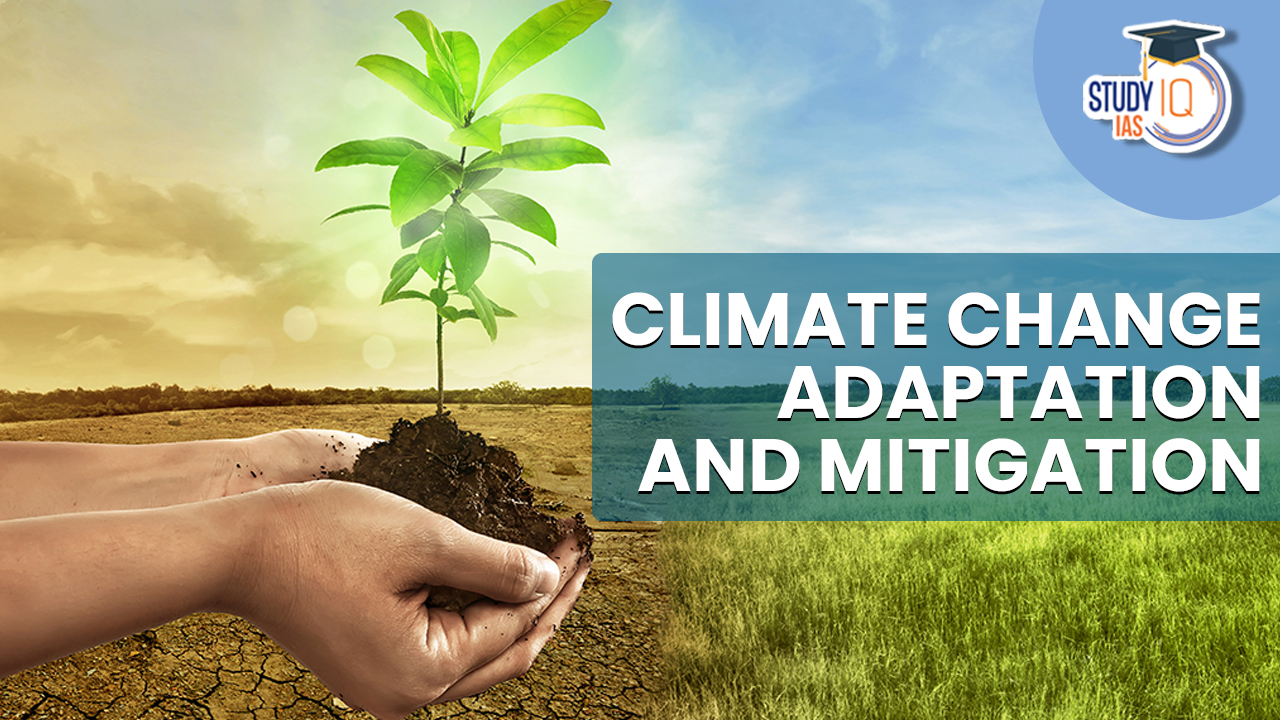Table of Contents
Climate Change Adaptation and Mitigation
There are two strategies that address climatic change: adaptation and mitigation. Mitigation addresses the root causes of climate change, while adaptation deals with its consequences. Adaptation involves making adjustments in response to climate change, whereas mitigation involves human interventions aimed at reducing the emissions of greenhouse gases, ultimately preventing a rise in temperatures.
Meaning of Adaptation
Adaptation refers to how a species alters its body and behaviour to better fit its natural environment. Currently, there are approximately 8.7 million species inhabiting the diverse environments of our planet, ranging from the icy, barren Arctic to the scorching sands of the Sahara. The natural environment of planet Earth is constantly evolving. The process of adaptation ensures that the species which adapt most effectively are the ones that survive.
Types of Adaptations
Adaptations in animals and plants are categorized based on their functions and observed responses. These categories include:
Structural Adaptations
These are unique features involving certain parts of an organism’s body, such as skin, colour, and shape. These adaptations are crucial for an organism’s survival in its natural habitat. Examples include the blubber of a whale, the beak of a woodpecker, and the baleen of a humpback whale.
Physiological Adaptations
These are mechanisms within an organism that enable it to carry out specific biochemical reactions for survival in its natural habitat. Examples include a snake’s ability to produce venom, a mammal’s capacity to regulate constant body temperature, and our body’s capability to produce acid for food digestion.
Behavioural Adaptations
These are specific ways an organism behaves to ensure its survival in its natural environment. Behavioural adaptations encompass actions like animal migration, hibernation, and aestivation.
Meaning of Mitigation
Climate change mitigation involves efforts to curtail global warming and its associated impacts. This chiefly pertains to diminishing human emissions of greenhouse gases (GHGs) and implementing measures to decrease their presence in the atmosphere. Alongside adaptation, mitigation constitutes one of the key responses to climate change. Virtually all nations have ratified the United Nations Framework Convention on Climate Change (UNFCCC). The primary objective of the UNFCCC is to stabilize GHG concentrations in the atmosphere at a threshold that averts perilous human interference with the climate system.
What is Climate Change Mitigation?
Climate Mitigation involves efforts to diminish or prevent the release of greenhouse gas emissions. This can be achieved through various means, such as adopting new technologies and renewable energy sources, enhancing the energy efficiency of existing equipment, or modifying management practices and consumer behaviour. It can range from intricate endeavours like redesigning city plans to straightforward changes in, for instance, the design of cook stoves.
While the concept of mitigation is relatively straightforward, its execution can be challenging. It requires a shift from reliance on fossil fuels to the utilization of clean, sustainable energy sources. Additionally, we must put a stop to deforestation and work towards restoring natural habitats until we attain a state of net-zero carbon emissions. This means that the amount of greenhouse gases released into the atmosphere is balanced by their capture and storage, such as in tree roots.
Strategies to Mitigate Climate Change
The Strategies to Mitigate Climate Change have been discussed below:
Carbon Sequestration
Carbon capture and storage (CCS), also known as carbon sequestration, encompasses technologies aimed at addressing global warming. These technologies involve capturing CO2 emissions from power plants, industrial facilities, or even directly from the atmosphere, and securely storing it underground for an indefinite period.
Carbon sequestration specifically pertains to the prolonged storage of carbon dioxide or other carbon forms to mitigate and delay global warming effects. This approach has been suggested as a means to decelerate the buildup of greenhouse gases in the atmosphere and oceans resulting from the burning of fossil fuels.
Carbon Sink
A carbon sink is a natural or human-made reservoir that gathers and retains carbon-containing compounds for an extended period, thereby reducing CO2 levels in the atmosphere. The two primary global carbon sinks are vegetation and the ocean. Since the implementation of the Kyoto Protocol, which promotes the utilization of CO2 sinks as a form of carbon offset, there has been a heightened public awareness of their significance.
The term “blue carbon” pertains to carbon captured by marine ecosystems. The majority of marine plant life comprises mangroves, salt marshes, and seagrasses, which store substantial amounts of carbon. Various endeavors are underway to enhance natural carbon sequestration in soils and oceans. Additionally, diverse artificial sequestration projects, including the development of new building materials, carbon capture and storage, and geological sequestration, are in progress.
Carbon Credit
A carbon credit is a permit that authorizes the holder to release a specific quantity of CO2 or other greenhouse gases. Each credit permits the emission of one metric ton of CO2 or its equivalent in other greenhouse gases. This credit is a fundamental element of a “cap-and-trade” program. Entities with emissions allowances are permitted to emit up to a defined limit, which is progressively reduced over time. Simultaneously, companies have the option to sell any unused credits to other companies in need.
This system offers private companies a dual incentive for curbing greenhouse gas emissions. Firstly, if their emissions surpass the established limit, they must invest in additional credits. Secondly, they have the opportunity to generate profits by reducing their emissions and selling any surplus allowances.
Carbon Offsetting
Carbon offsetting is often the fastest way for businesses to achieve substantial reductions in emissions. Additionally, it frequently brings about supplementary benefits at the project location, including job creation, community development initiatives, and opportunities for training and education.
For a carbon offset to be considered credible, it must adhere to key quality criteria, such as:
- Demonstrated Additionality: There must be evidence that the emissions reduction would not have taken place without the financial support from carbon offsetting.
- Retirement Assurance: The offset must be taken out of the carbon market to prevent it from being counted multiple times.
- Addressing Permanence and Leakage: It should ensure that the stated reductions are effectively delivered and that the reduction of emissions in one area does not lead to an increase in emissions elsewhere.
Carbon Tax
A Carbon Tax is a type of pollution levy that charges a fee on the production, distribution, and utilization of fossil fuels, determined by the quantity of carbon emissions generated during combustion. It stands as a potential alternative to the current ‘cap and trade’ method employed by the protocol.
This tax is levied based on the carbon content within fuels, such as coal, for instance. Its objective is to diminish the reliance on fossil fuels while creating an incentive to shift towards alternative energy sources. If implemented, the carbon tax would be introduced gradually, commencing with a modest levy and incrementally rising. This phased approach allows for the advancement of superior industries and technologies.
Geo-Engineering
Geoengineering, a form of climate engineering or deliberate human intervention in the climate, aims to bring about long-term changes in Earth’s climate patterns. Its primary goal is to modify and cool the Earth’s environment, with the aim of mitigating environmental damage, countering resulting climate shifts, and ultimately creating a more hospitable planet.
Various approaches fall under the umbrella of geoengineering, including deploying parasols in space, positioning mirrors in orbit, using sulfate aerosols to brighten the stratosphere, applying reflective coatings to building roofs, and introducing iron filings into the ocean to stimulate carbon-absorbing algae.
Present-day geoengineering proposals predominantly centre on two critical objectives: reversing global warming and extracting carbon dioxide from the atmosphere. However, in theory, large-scale geoengineering initiatives could target any facet of Earth’s ecosystems or climate system, potentially addressing the impacts of global warming, ocean acidification, the depletion of Arctic ice, or even volcanic eruptions breaking through the Earth’s surface.
Measures to Mitigate Climate Change
- Improving energy efficiency and conservation, as well as establishing a Bureau of Energy Efficiency
- Reforms to the power sector
- Promoting hydro and renewable energy
- Promotion of clean coal technologies
- Coal washing and efficient utilisation of coal
- Forest reforestation and conservation
- Reduced gas flaring
- Cleaner, less carbon-intensive transportation fuel
- Encourage the use of Mass Rapid Transit systems
- Management of environmental quality and increased energy efficiency
Global Initiatives to Reduce Greenhouse Gas Emissions
The Intergovernmental Panel on Climate Change (IPCC) was established in 1988 by the World Meteorological Organization (WMO) and the United Nations Environment Programme (UNEP). Its purpose is to provide policymakers with periodic assessments of the scientific foundation of climate change, including its impacts, future risks, and potential strategies for adaptation and mitigation.
The United Nations Framework Convention on Climate Change, signed in 1992 and enacted in 1994, aims to achieve the “stabilization of atmospheric greenhouse gas concentrations at a level that would prevent dangerous anthropogenic intervention with the climate system.”
The Kyoto Protocol (KP), adopted at the 3rd COP in 1997, is an international agreement designed to reduce global greenhouse gas emissions by a minimum of 5% compared to 1990 levels by 2012. This agreement targeted a range of greenhouse gases, including CO2, CH4, N2O, Hydrofluorocarbons (HFCs), Perfluorocarbons (PFCs), and Sulfur Hexafluoride (SF6), for reduction.
Climate Change Adaptation and Mitigation UPSC
Mitigation efforts will require decades to noticeably influence the rising temperatures. Therefore, it is imperative that we adapt promptly to the changes that are already underway and will persist in the foreseeable future. The sooner we take action to mitigate the impacts of climate change, the more favorable our future will be. While the world has been sluggish in its response thus far, there is a noticeable shift in momentum. Both adaptation and mitigation are equally crucial and time-critical, necessitating simultaneous attention. Climate change is a grave concern, but our planet can endure and flourish if we collaborate to avert the most severe consequences and adjust to our evolving environment.


 Goods and Services Tax (GST), Objectives...
Goods and Services Tax (GST), Objectives...
 World Oceans Day 2025, History, Theme, S...
World Oceans Day 2025, History, Theme, S...
 World Environment Day 2025, Theme, Histo...
World Environment Day 2025, Theme, Histo...





















